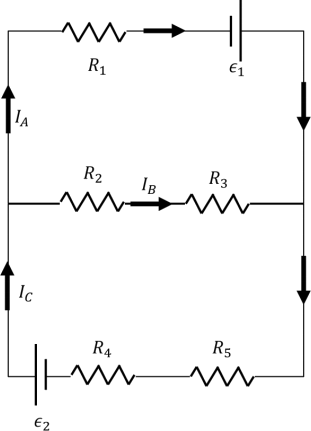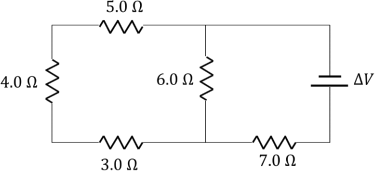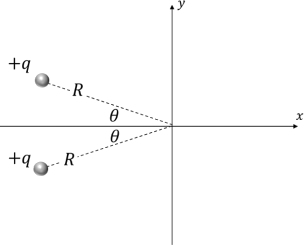PHYSICS 132 – Winter 2023 Term Test #1
Hello, dear friend, you can consult us at any time if you have any questions, add WeChat: daixieit
PHYSICS 132 - Winter 2023
Term Test #1
Questions
1. A plastic rod that has been charged to +10 nC touches a metal sphere. Afterward, the rod’s charge is +16 nC. What kind of charged particle was transferred between the rod and the sphere and in which direction?
a. Protons moved from the rod to the sphere.
b. Electrons moved from the rod to the sphere.
c. Protons moved from the sphere to the rod.
d. Electrons moved from the sphere to the rod.
2. Two charges are placed along +x axis, as shown in the figure below. Charge QA is positive and the electric field  = 0 at the point between the charges, indicated in the picture. Which of the following statement is true about charge QB?
= 0 at the point between the charges, indicated in the picture. Which of the following statement is true about charge QB?

a. QB is negative and |QA| > |QB|.
b. QB is negative and |QA| < |QB|.
c. QB is positive and |QA| > |QB|.
d. QB is postive and |QA| < |QB|.
3. Two charges, q1 and q2 are placed along x axis at x1 = −3.0 m and x2 = +1.0 m , respectively. The electric potential from the two charges, measured along x axis, is shown in the figure. What can you deduce about the sign on the charges?
a. q1 is positive, q2 is negative.
b. q1 is negative, q2 is positive.
c. Both q1 and q2 are positive.
d. Both q1 and q2 are negative.

4. Two identical, small spheres of charges q1 = +2e and q2 = +6e experience force of magnitude FA when separated by distance T . The spheres are brought in contact with each other and then separated by the same distance T , where they experience force of magnitude FB . What is the ratio of the magnitudes of the forcesF  ?
?
a.  = 3/4
= 3/4
b.  = 3
= 3
c.  = 3/1
= 3/1
d.  = 4/3
= 4/3
5. Consider the multi-loop circuit shown in the picture. Which of the Kirchhoff’s equations for this circuit is incorrect?
a. −IAR1 + E1 + IBR3 + IBR2 = 0
b. −E2 + ICR4 + ICR5 + IBR3 + IBR2 = 0
c. −IAR1 − E1 + IBR3 + IBR2 = 0
d. −IAR1 + E1 − ICR5 − ICR4 + E2 = 0

6. What is the equivalent resistance of the circuits shown in the picture below?

a. Req = 25.0 Ω
b. Req = 11.0 Ω
c. Req = 6.25 Ω
d. Req = 2.50 Ω
7. In certain region in space a non-uniform electric field is present. Figure below shows the equipotential lines in that region. Based on the information provided in the picture, what is the x component of the electric field at point P located atx = 5.0 cm?

a. Ex = +2000
b. Ex = −2000
c. Ex = +1000
d. Ex = −1000
8. A positron (me, +e) and an electron (me, −e) areplaced in a uniform electric field E and released. Which of the following statements is true?
a. The particles will experience accelerations of the same magnitude in the same direction.
b. The particles will experience accelerations of the same magnitude in opposite directions.
c. The particles will experience accelerations of different magnitudes in the same direction.
d. The particles will experience accelerations of different magnitudes in opposite directions.
Questions 9 and 10 are referring to the same scenario:
Two positive charges, q = 3.60 μC, are located distance R = 0.070 m away from the origin, one at angle θ = 25.0o above −x axis and one at the same angle below −x axis, as shown in the picture.

9. What is the total electric potential due to these two charges at the origin?
a. V = 1.02 MV
b. V = 0.925 MV
c. V = 0.838 MV
d. V = 0 V
10. What is the magnitude of the net electric field due to these two charges at the origin?
a. E = 1.61 × 107
b. E = 1.32 × 107
c. E = 1.20 × 107
d. E = 0.558 × 107
Two stationary charges, QA = +3.0 μC and QB = −3.0 μC are placed distance d = 0. 120 m apart as shown in the picture below. A negative charge q = −2.00 μC and mass m = 1.00 × 10−6 kg is launched from a mid-point between the charges with a velocity v = 1.84 × 103 to the right.
to the right.
a. In the figure below indicate the initial position of the charge q, the direction of its initial velocity, and the direction of the net electric force exerted on it by the other two charges. [1 point]

b. What is the initial kinetic energy of the charge q? [2 points]
c. What is the initial potential energy of the charge q? [2 points]
d. What is the potential energy of the charge q after it travels through a displacement Δx = +0.0240 m? [2 points]
e. What is the speed of the charge q after it travels through the displacement Δx = +0.0240 m? [3 points]
2024-02-25